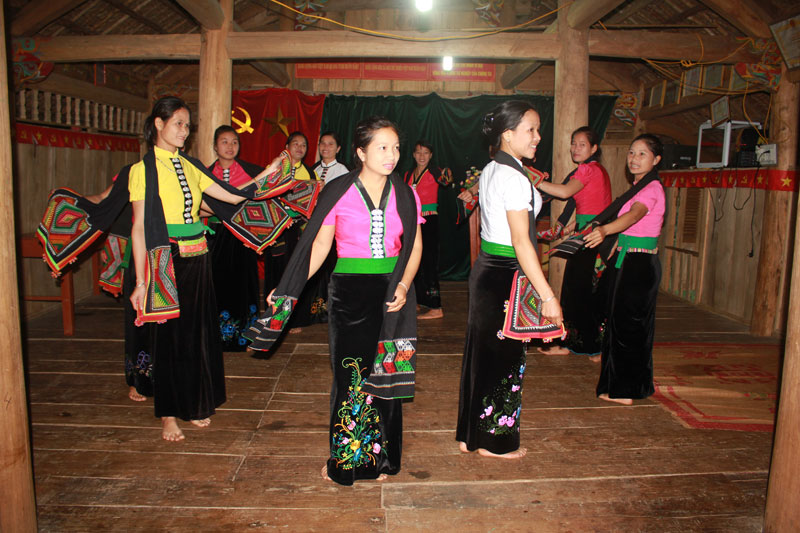
HBO – It is enduringly popular to see Tay ethnic women wearing their traditional costume when rambling around Da Bac town and Tan Minh, Tan Pheo, Giap Dat and Muong Chieng communes. Integrating with the modern life, the Tay ethnic group, accounting for 40.57 percent of the population of Da Bac district, is preserving and promoting their traditional cultural characteristics every day.
An art troupe in Na Man and Muong Chieng communes in Da Bac district
stages an performance in their traditional costume.
Unlike
men’s outfit, women’s clothing is more sophisticated with three kinds of shirts,
namely short shirts, V-neck style short shirt without button and long shirt, head
scarf, bibs, silk dress and belt.
According
to Xa Thi Thay, head of the art troupe, the colourful traditional costumes show
off Tay women’s beauty and charm. Besides special occasions like Tet or
traditional festivals, the garb is used in Tay women’s daily activities as part
of efforts to preserve their cultural values.
Highlight of the dress is a tight-fitting short shirt with a band clipped with
two lines of silver buttons in the shape of butterfly or cicada. Five, seven or
nine pairs of buttons are arranged in the short shirt. Meanwhile, the
sleeveless bibs are in pink and black colours with sequin decoration in their
necks.
The black or indigo knee-length dresses have two kinds: one with embroidered
waistband and the remainder with sunken floral patterns. Meanwhile, the
skillfully-embroiled Pieu ethnic scarf is a vivid illustration for the Tay
ethnic people’s excellent culture.
The Tay women also use such accessories as necklace, bracelet, earrings and
silver or gold rings.
With an increasingly vibrant and widespread emulation movement aimed at building cultured residential areas and cultured families, Yen Thuy District has been making steady progress toward improving both the material and spiritual well-being of its people, while fostering a civilized, prosperous, beautiful, and progressive community.
Once lacking recreational spaces and community facilities, Residential Group 2 in Quynh Lam Ward (Hoa Binh City) has recently received attention for the construction of a new, spacious, and fully equipped cultural house. The project followed the model of state support combined with public contributions in both labor and funding.
The "All people unite to build cultural life" movement, which has been effectively integrated with Kim Boi district’s socio-economic development goals, is fostering a lively spirit of emulation across local residential areas, hamlets, villages, public agencies, and enterprises. In addition, through the initiative, traditional cultural values are being preserved and promoted, while community solidarity and mutual support in poverty reduction and economic development are being strengthened.
A working delegation of the Hoa Binh provincial People’s Committee led by its Permanent Vice Chairman Nguyen Van Toan on June 11 inspected the progress of a project to build the Mo Muong Cultural Heritage Conservation Space linked to tourism services in Hop Phong commune, Cao Phong district.
Born and growing in the heroic land of Muong Dong, Dinh Thi Kieu Dung, a resident in Bo town of Kim Boi district, in her childhood was nurtured by the sweet lullabies of her grandmother and mother. These melodies deeply imprinted on her soul, becoming an inseparable part of her love for her ethnic group's culture. For over 20 years, this love for her hometown has driven Dung to research, collect, and pass down the cultural values of the Muong people to future generations.
In the final days of May, the Ethnic Art Troupe of Hoa Binh Province organized performances to serve the people in remote, mountainous, and particularly disadvantaged areas within the province. These were not just ordinary artistic shows, but they were the meaningful journeys aimed at spreading cultural values, enhancing the spiritual life of the people and contributing to the preservation of ethnic minority cultural identities.



